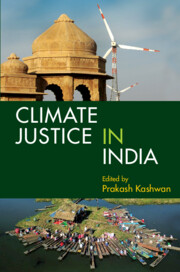Book contents
- Frontmatter
- Contents
- List of Poems and Artworks
- List of Tables
- List of Figures
- List of Abbreviations
- Preface and Acknowledgements
- 1 Introduction: Climate Justice in India
- 2 Urban Climate Justice in India
- 3 How Just and Democratic Is India’s Solar Energy Transition?: An Analysis of State Solar Policies in India
- 4 Extractive Regimes in the Coal Heartlands of India: Difficult Questions for a Just Energy Transition
- 5 Climate Justice Implications of the Relationship between Economic Inequality and Carbon Emissions in India
- 6 Climate Action Plans and Justice in India
- 7 Social Mobilizations for Climate Action and Climate Justice in India
- 8 Reimagining Climate Justice as Caste Justice
- 9 Intersectional Water Justice in India: At the Confluence of Gender, Caste, and Climate Change
- 10 Realizing Climate Justice through Agroecology and Women’s Collective Land Rights
- 11 Conclusion: Pathways to Policies and Praxis of Climate Justice in India
- About the Editor and Contributors
- About the Poets and Artists
- Index
8 - Reimagining Climate Justice as Caste Justice
Published online by Cambridge University Press: 03 November 2022
- Frontmatter
- Contents
- List of Poems and Artworks
- List of Tables
- List of Figures
- List of Abbreviations
- Preface and Acknowledgements
- 1 Introduction: Climate Justice in India
- 2 Urban Climate Justice in India
- 3 How Just and Democratic Is India’s Solar Energy Transition?: An Analysis of State Solar Policies in India
- 4 Extractive Regimes in the Coal Heartlands of India: Difficult Questions for a Just Energy Transition
- 5 Climate Justice Implications of the Relationship between Economic Inequality and Carbon Emissions in India
- 6 Climate Action Plans and Justice in India
- 7 Social Mobilizations for Climate Action and Climate Justice in India
- 8 Reimagining Climate Justice as Caste Justice
- 9 Intersectional Water Justice in India: At the Confluence of Gender, Caste, and Climate Change
- 10 Realizing Climate Justice through Agroecology and Women’s Collective Land Rights
- 11 Conclusion: Pathways to Policies and Praxis of Climate Justice in India
- About the Editor and Contributors
- About the Poets and Artists
- Index
Summary
The contribution of colonialism and imperial expropriation to the unfolding climate crisis has been well documented on a global scale. This chapter seeks to interrogate the role of caste as a structural element in shaping environmental inequities within India and beyond. Scientists across disciplines agree that the current system of production is unsustainable at the planetary level, even if a consensus on how to address this issue remains elusive. I argue that in the case of India, accounting for historical and contemporary caste-based extraction is crucial for any meaningful realization of climate justice.
Globally, academic scholarship and policy have come to acknowledge the uneven and unjust ways in which the burden and responsibility for the current crisis are distributed across nations, ethnicities, races, and genders. There is an emerging consensus that the historical pathways of colonialism and capitalist development are directly responsible for this uneven distribution. This pattern is seen across the histories of energy production, plantation economies, and commercial agriculture, as demonstrated in the detailed work of political ecologists (for example, Li 2017). Consequently, the idea that mitigation, adaptation, and resilience-building strategies must account for this historical unevenness is no longer controversial.
We see this acknowledgement in the principle of ‘common but differentiated responsibility’ formally adopted by the United Nations in 1992. Under this principle, world governments recognize the lesser contribution of formerly colonized countries such as India towards planetary environmental degradation. This can be read as an acknowledgement of the unequal distribution of political power and economic prosperity across world nations because of colonialism. Acknowledging this historicity of the climate crisis is important, but our understanding of it would remain incomplete without a serious stock-taking of those dimensions of inequality and unevenness that significantly pre-date the rise of colonial capitalism and are yet implicated in its development trajectory. These dimensions of inequality often operate at the national or sub-national levels and therefore escape scrutiny on the global stage. In the case of India, one such important and all-pervasive dimension of inequality is caste.
For decades, anthropological and historical scholarship on caste focused only on ritual, scriptural, and mythical dimensions, thus constructing the issue as a matter of religion alone. Anti-caste scholars and activists such as Ambedkar, Phule, and Periyar have resisted such ‘orientalist’ representations of caste.
- Type
- Chapter
- Information
- Climate Justice in India , pp. 162 - 182Publisher: Cambridge University PressPrint publication year: 2025
- Creative Commons
- This content is Open Access and distributed under the terms of the Creative Commons Attribution licence CC-BY-NC 4.0 https://creativecommons.org/cclicenses/

